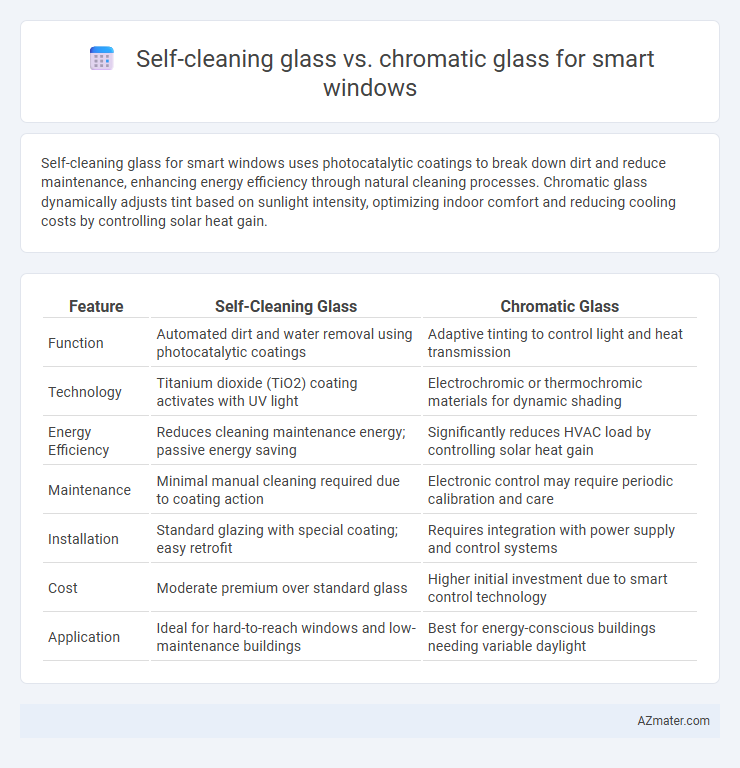Self-cleaning glass for smart windows uses photocatalytic coatings to break down dirt and reduce maintenance, enhancing energy efficiency through natural cleaning processes. Chromatic glass dynamically adjusts tint based on sunlight intensity, optimizing indoor comfort and reducing cooling costs by controlling solar heat gain.
Table of Comparison
| Feature | Self-Cleaning Glass | Chromatic Glass |
|---|---|---|
| Function | Automated dirt and water removal using photocatalytic coatings | Adaptive tinting to control light and heat transmission |
| Technology | Titanium dioxide (TiO2) coating activates with UV light | Electrochromic or thermochromic materials for dynamic shading |
| Energy Efficiency | Reduces cleaning maintenance energy; passive energy saving | Significantly reduces HVAC load by controlling solar heat gain |
| Maintenance | Minimal manual cleaning required due to coating action | Electronic control may require periodic calibration and care |
| Installation | Standard glazing with special coating; easy retrofit | Requires integration with power supply and control systems |
| Cost | Moderate premium over standard glass | Higher initial investment due to smart control technology |
| Application | Ideal for hard-to-reach windows and low-maintenance buildings | Best for energy-conscious buildings needing variable daylight |
Introduction to Smart Window Technologies
Smart window technologies incorporate self-cleaning glass and chromatic glass to enhance energy efficiency and user convenience. Self-cleaning glass utilizes photocatalytic and hydrophilic coatings to break down organic dirt and prevent buildup, reducing maintenance. Chromatic glass employs electrochromic or thermochromic materials to adjust transparency and control solar heat gain, optimizing natural light and indoor temperature.
What is Self-Cleaning Glass?
Self-cleaning glass features a special coating that uses photocatalytic and hydrophilic properties to break down organic dirt and allow rainwater to wash it away, minimizing maintenance in smart windows. It enhances durability and clarity by reducing dirt accumulation, which is crucial for energy-efficient smart building applications. Compared to chromatic glass, which adjusts light transmission, self-cleaning glass primarily improves cleanliness and reduces cleaning frequency.
What is Chromatic Glass?
Chromatic glass, also known as smart or switchable glass, changes its light transmission properties based on electrical voltage, temperature, or light intensity, enhancing energy efficiency and privacy in smart windows. Unlike self-cleaning glass, which uses a photocatalytic coating to break down organic dirt, chromatic glass actively controls solar heat and glare by adjusting its tint dynamically. This adaptive feature reduces the need for artificial lighting and climate control, contributing to sustainable building design.
Key Features of Self-Cleaning Glass
Self-cleaning glass features a special photocatalytic coating that breaks down organic dirt using sunlight and uses rainwater to wash away debris, reducing maintenance efforts significantly. Its hydrophilic surface ensures even water distribution, preventing streaks and enhancing clarity. This technology improves energy efficiency and visibility without requiring manual cleaning, distinguishing it from chromatic glass, which primarily focuses on light and heat modulation through electrochromic or thermochromic properties.
Key Features of Chromatic Glass
Chromatic glass for smart windows features dynamic light modulation, enabling automatic tint changes in response to sunlight intensity, which enhances energy efficiency and glare reduction. This glass type supports precise control over transparency and color, improving indoor comfort and privacy without obstructing external views. Unlike self-cleaning glass, chromatic glass primarily focuses on solar heat gain regulation and aesthetic customization rather than surface cleanliness.
Energy Efficiency Comparison
Self-cleaning glass enhances energy efficiency in smart windows by reducing maintenance needs and maintaining optimal solar heat gain through its photocatalytic and hydrophilic coatings. Chromatic glass adjusts light transmission in response to external conditions, effectively controlling solar heat input and minimizing cooling and heating demands. Energy savings from chromatic glass typically surpass self-cleaning glass due to its active modulation of light and heat, making it more effective for dynamic climate control.
Maintenance and Durability
Self-cleaning glass in smart windows utilizes photocatalytic and hydrophilic coatings that reduce dirt accumulation and simplify cleaning, significantly lowering maintenance efforts over time. Chromatic glass, designed with electrochromic or thermochromic layers, requires periodic calibration and careful handling to maintain optimal performance, potentially increasing long-term maintenance needs. In terms of durability, self-cleaning glass coatings are generally more resistant to environmental wear, while chromatic glass materials may experience gradual degradation of color-changing properties after extensive use or exposure.
Cost and Installation Factors
Self-cleaning glass typically offers lower upfront costs and simpler installation processes compared to chromatic glass, which requires advanced technology integration and precise calibration, increasing both expenses and complexity. Chromatic glass demands specialized electrical wiring and control systems that elevate installation time and labor costs, whereas self-cleaning glass mainly involves surface coating applications with minimal setup. Budget-conscious projects benefit from the affordability and ease of self-cleaning glass, while chromatic glass suits installations prioritizing dynamic light control despite higher financial and technical commitments.
Ideal Applications for Each Glass Type
Self-cleaning glass is ideal for high-rise buildings, skylights, and facades exposed to pollution and weather elements where maintenance access is challenging, ensuring consistent transparency and reduced cleaning costs. Chromatic glass excels in residential and commercial smart windows, offering dynamic control of light and heat by adjusting tint levels to enhance energy efficiency and occupant comfort. Combining both technologies suits environments requiring minimal upkeep and adaptive light management, such as green buildings and smart homes.
Choosing the Right Smart Glass for Your Needs
Self-cleaning glass for smart windows uses photocatalytic and hydrophilic coatings to reduce maintenance by breaking down organic dirt and allowing rain to wash it away, ideal for exterior applications requiring minimal upkeep. Chromatic glass, or smart tinting glass, adjusts its transparency electronically to control light and heat transmission, enhancing energy efficiency and privacy in various indoor environments. Choosing the right smart glass depends on prioritizing either low-maintenance cleaning features or dynamic light control, based on the specific needs of your building's location, usage, and energy goals.

Infographic: Self-cleaning glass vs Chromatic glass for Smart window
 azmater.com
azmater.com